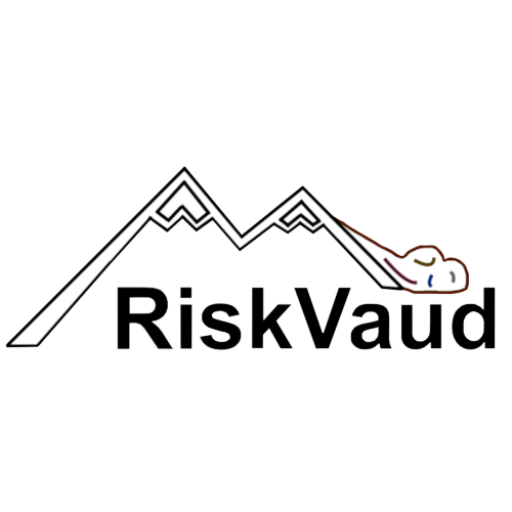Risk
Nicolas Serrano
As part of the earth system, we are exposed to many natural phenomena that occur on the surface of the planet earth, whether through gravitational, climatic or geological processes. We know these events as natural hazards and some of the most known are earthquakes, snow avalanches, volcanic eruptions, landslides or floods.
These hazards can affect us as a society at different levels, as economic, environmental and personal aspects, ultimately reducing our quality of life and hindering our development as communities and individuals. Unfortunately, it is inevitable to be affected by such events, however, their impact can be considerably reduced through natural disaster risk assessment and management.
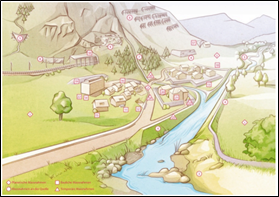
Alpine landscape Source: Swiss National platform for natural hazards
What is risk?
Risk is defined by the Oxford Learner’s Dictionary as the possibility of something bad happening at some time in the future or a situation that could be dangerous or have a bad result. This concept is used in many areas of knowledge, for example in economics to account for the possibility of investment losses or in health sciences to account for the medical consequences of certain events such as habits or congenital conditions.
n general terms, the concept of risk has been created to understand the probability of something happening that may be harmful in a given time. In this sense, to understand risk, it is important to understand the most basic definition of probability.

Probability is simply how likely is something to happen. This can be calculated by knowing the possible outcomes and the factors that can affect them. A simple example is the roll of a die. We do not know for sure which side will land but we know all the options, so we know how likely it is that a certain number or set of numbers will land. Thus we know that the probability of a 6 falling is 16.6% (1/6)*100 or 50% (3/6)*100 of an even number falling.
Why is it important
When we talk about disaster risk, we are basically referring to the potential health impacts, loss of human life and destruction or affectation of assets that can occur in a system, society or community in a given period of time. This concept emerges from the idea that damages and losses can be reduced or avoided in case of threatening events.
This risk can be quantified through probability, which in this case is slightly more complex than in our previous example, as it takes into account other factors such as the nature of the hazard, and exposure and vulnerability of elements.
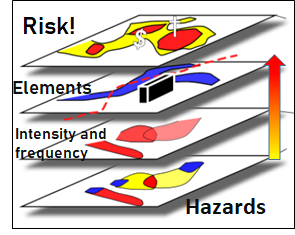
The risk zoning process. Modified from Jaboyedoff, 2021.
Understanding all the factors influencing the final risk is fundamental to assessing it. Therefore, understanding the dynamic nature (their behaviour) of hazards such as mass movements, floods, snow avalanches, and how large or strong they could be (intensity) and how often they could occur (frequency) is vital. Moreover, by adding detailed knowledge of the type and quantity of elements (e.g. houses, routes, people, etc) potentially affected, risks can be assessed and mapped at different levels of detail.
Can we reduce risk?
Yes, risk can be reduced in a number of ways by managing some of the factors that influence it. For example, we can reduce risk by reducing exposure, this can be done by not building on sites susceptible to natural hazards or by building with cheap, easily replaceable materials for non-habitable buildings. It can also be reduced by mitigation works that help to control or eliminate hazards, such as retaining walls for landslides and rock falls, or riverbank barriers to reduce flood intensity and frequency. Another way to reduce risk is through early warning systems, which basically depends on reducing risk by taking timely action in the presence of imminent or likely events, this means evacuating zones that are more likely to be affected by a highly probable or imminent event after an official warning signal.
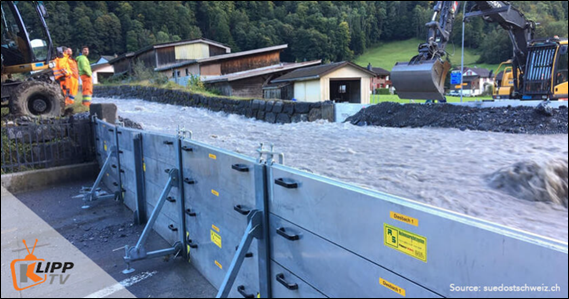
Flood barrier on the sides of the Diesbach river in the village of Glarus Süd, Switzerland in 2020.
What can we do in our houses and communities?
We, as part of communities, are a very important actor in disaster risk management. By being prepared and attentive to precaution alerts and being conscious of our surroundings, we can prevent and reduce a lot of damage and losses when a hazardous event happens. Thus, it is important to know the environmental authorities that manage risk in our region and to obtain information on present and latent hazards, either through these authorities or through local official media. It’s also important to corroborate information with these authorities as imprecise or wrong information can have dangerous consequences and distract us from the real hazards.
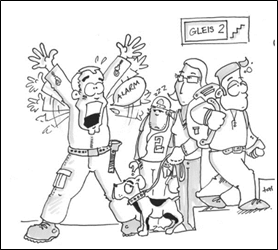
Cartoon from Timo Albeiz in the national platform of natural hazards.
Sometimes, knowledge of the terrain, observing changes in the shape of hillsides, movement of trees or fences, abnormal changes in the level or color of rivers and streams can be valuable and if possible should be reported to any concerning authority. It is also important to be prepared for emergencies, with evacuation routes, meeting points and emergency kits.
All in all, disaster risk management is one of the basis of development and well being for us and our society nowadays. We are living challenging times with local and global climate changes, in which our only solution is to adapt. In this respect, it is important for researchers, territorial authorities and competent organizations to understand risk and all its components, collecting data, strengthening models and making decisions based on it. On the other side, it is our duty as community to be attentive of this information, and to be prepared and resilient for this kind of events.
